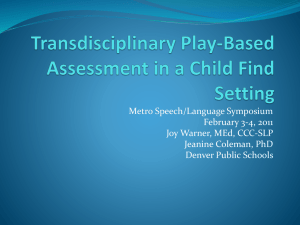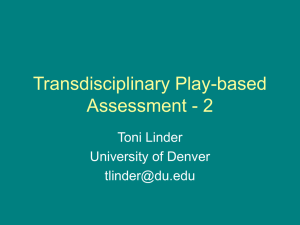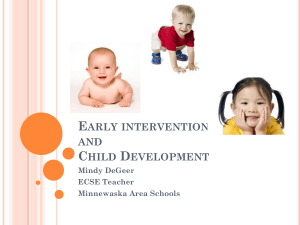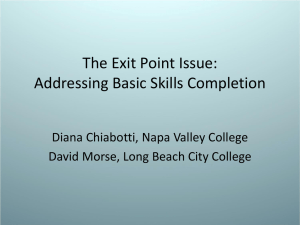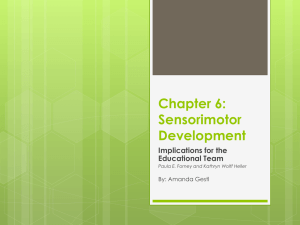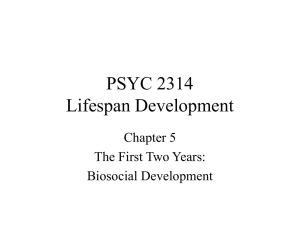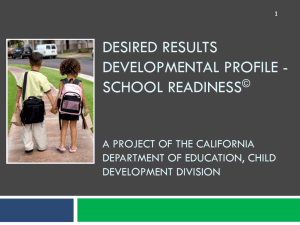Transdisciplinary Playbased Assessment in a Child Find Setting
advertisement
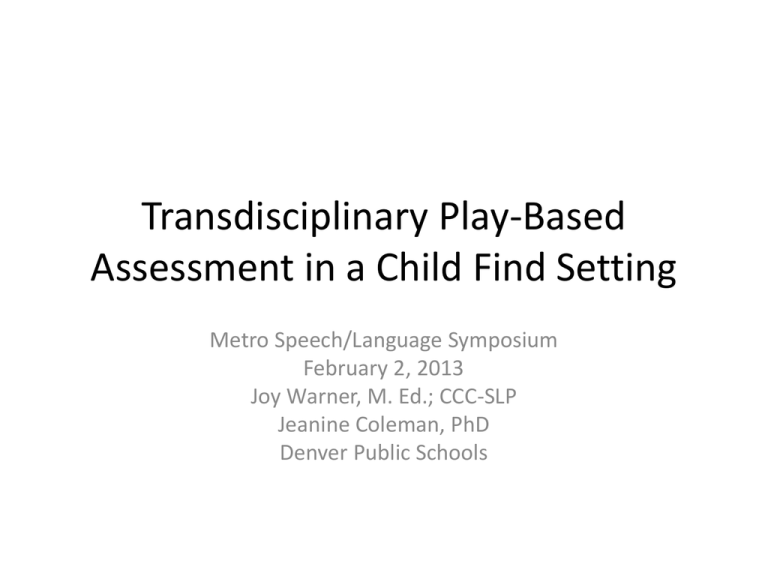
Transdisciplinary Play-Based Assessment in a Child Find Setting Metro Speech/Language Symposium February 2, 2013 Joy Warner, M. Ed.; CCC-SLP Jeanine Coleman, PhD Denver Public Schools Goals of the Presentation Participants will: • Gain understanding of the TPBA process with Child Find teams. • Will observe best practices in assessment process. • Learn facilitation strategies. • Gain understanding of how to create functional, family sensitive goals and recommendations. Characteristics of the TPBA • • • • • • • • • • Play-based Dynamic Functional Flexible Authentic Multi-dimensional Collaborative Child & Family focused Strengths based Sensitive to child and family differences Purpose of TPBA • To determine eligibility for Part C and Part B special education services and write Individualized Family Service Plans (IFSP) or Individualized Education Plans/Programs (IEP) • To identify intervention strategies or intervention plans specific to individual children Type of assessment • “TPBA is an authentic process that involves observing the child in play situations with structured and unstructured facilitation of sensorimotor, social-emotional, language and communication, and cognitive development” (p. 8). • TPBA is not a standardized, norm-referenced assessment • TPBA is not a criterion-referenced assessment • TPBA is not a developmental checklist • TPBA is an assessment process that uses multiple sources of information across settings to determine strengths and needs of children. Developmental domains assessed • • • • • • Cognition Speech & Language Gross & Fine Motor Sensory Emotional & Social INTERRELATEDNESS Results in quantitative and qualitative information related to: • • • • Skill level (Age Tables) Learning style (Observation Guidelines) Interaction patterns (Observation Guidelines) Contexts for development (Observation Guidelines & parent reports) • Intervention objectives and strategies (Observation Guidelines & TPBI strategies) Defining Transdisciplinary Teams • • • • • • • • Teams working together to assess children across disciplines Exchanging of roles or role release Flexibility Collaborative Integrative Effective Supportive Results in holistic evaluations Roles of team members • • • • Child Family (parents, grandparents, caregivers) Play facilitator—person who plays with the child Parent/family facilitator—person who observes with the parent and discusses assessment processes • Videographer—person recording the assessment • Observers/note-takers—the rest of the team that observes and takes notes during the assessment on TPBA forms Other Team members • ECSE—Early Childhood Special Educator or Developmental Specialist • OT/PT—Occupational/Physical Therapist • SLP—Speech/Language Pathologist • School Psychologist • Nurse • Audiologist/Hearing Specialist • Vision Specialist • Early Childhood Teachers and classroom assistants • Child care provider Who is assessed? • • • • • • • • • • Children birth to 6 years Children who have previously be labeled “untestable” Children with short attention spans Children with limited mobility Children with social-emotional problems Children with autism Children with genetic disorders Children who are developing in a typical manner Children who may be gifted Children who are at risk for developmental delays Components • Information from parents – Child & Family History Questionnaire (CFHQ) – Family Assessment of Child Functioning (FACF) Tools: Daily Routines Rating Form; All About Me Questionnaire • Observations of the child – TPBA2 Observation Guidelines & Age Tables • Analysis & discussion of information to get a holistic view of the child • Program planning & recommendations for intervention (next steps) TPBA Process—what’s involved? 1. 2. 3. 4. 5. 6. Obtain information from families related to developmental, health, and social history of the child and family Obtain information from families and caregivers related to how they view the child’s development, behavior, and interactions within daily routines Obtain information from caregivers as they observe the child during TPBA in order to determine how the child’s behavior during the assessment is similar or different from what they typically see Obtain information from team members who observe the child at play regarding developmental skills, behaviors, processes, learning style and interaction patterns Integrate and share information in a post-assessment discussion with family members Write a comprehensive, holistic report that reflects the perspective of the family and the professionals involved in the evaluation; identifies a disability, delay, or concern through the assessment process; specifies global service needs; and provides specific recommendations that address: – What skills, behaviors or processes the child is “ready for” and why – How the “next steps” can be addressed – Examples of activities or experiences from home and/or school that will support learning (pp.8-9) Family Facilitation • • • • Before, during, and after TPBA Listen to the story Identify concerns Provide information – On TPBA – Family’s role • Obtain additional information • Compare child’s behaviors at TPBA session & home • Identify priorities of the family • Use cultural responsiveness and sensitive communication skills Toys & Materials 1. A full range of categories of play 2. Familiar & unfamiliar experiences 3. Simple and challenging problem-solving opportunities 4. Varying types of mild to intense sensory stimulations 5. Independent and social play opportunities 6. Communication opportunities 7. Opportunities for fine motor skills 8. Opportunities for gross motor skills 9. Opportunities to use pre-academic skills 10.Means for addressing specific referral questions Structure of the TPBA Session • Balance between observation of child’s independent play, spontaneous behaviors, following the play facilitator’s lead, structured facilitation, and responding to limits • Parental (or caregiver) play with the child in both unstructured and structured interactions (e.g. sharing a snack, reading a story, completing a puzzle, or playing a game) • Separation from and reunion with parents (or caregivers) • Child-to-child interactions with siblings and/or peers • Unstructured and structured motor play • Inclusion of natural events (e.g. snack, toileting, dressing/undressing with outer clothing) • Contrived events or situations to elicit questioned skills or behaviors (e.g. tantrums) Natural & Contrived Events • Watch for key events: – – – – – – – – – – How the child enters the new environment Responds to new people or the presence of a group Interacts/plays with new toys and materials Transitions from one activity to another Deals with challenging tasks and unsuccessful attempts Responds to limits from parents and/or play facilitator Handles unexpected sensory input Tolerates brief separation from caregivers Handles having to stop playing with a toy/materials Responds to unexpected events or stimulation (e.g. someone new enters the room, loud noises) Play Facilitation: The art of interaction • Watch & wait: Do nothing, say nothing • Assist as little as possible, but prompt, suggest, or provide physical support as needed • Imitate the child • Take turns with actions and/or communication • Model actions or language and motive the child to engage with materials • Oral & non-oral communication includes open-ended questions, fewer questions, and more comments • Read cues and respond immediately to all initiations (language or actions) • Enthusiasm is contagious! Play Facilitation—Adaptations • • • • • • • • Changing the facilitator Changing the environment Adapting toys & materials Positioning materials Positioning child Modifying sensory input Using assistive technology Using therapeutic strategies Observing Kassandra Observation Guidelines: Communication Development • • • • • • • Language comprehension Language production Pragmatics Articulation/phonology Voice & fluency Oral mechanism Hearing Observation Guidelines: Emotional & Social Development • • • • • • • Emotional express Emotional/style/adaptability Regulation of emotions & arousal states Behavioral regulation Sense of self Emotional themes in play Social interactions • • • • • Observational Guidelines: Sensorimotor Development Functions underlying movements Gross motor ability Arm & hand use Motor planning & coordination Modulations of sensation and its relationship to emotion, activity level, and attention • Sensorimotor contributions to daily life and self-care • Vision Observation Guidelines: Cognitive Development • • • • • • • Attention Memory Problem solving Social cognition Complexity of play Conceptual knowledge Literacy Introducing the TPBA forms • Observation Guidelines – – – – – Questions Strengths Examples of behaviors of concern “Ready for” Notes • Observation Notes • Age Tables – Age level (1 month to 72 months) – Subcategory • Observation Summary Forms – Subcategory – Level of child’s ability (1-9 point scale) – Rating compared with other children of same age Analyzing the data • After the play session, the team meets to review & summarize data which includes: – Observation Notes – Observation Guidelines – Observation Summary – DPS TPBA Summary Form • Parents – CFHQ – Daily Routine Ratings Form – All About Me DPS TPBA Summary Form Child’s Name: Date of Birth: Date of Profile: Age: Qualitative Concerns: Rating 4 Definite Concern (severe) 34-50% delay 3 Concern (moderate) 25-33% delay 2 Watch (mild) 10-24% delay 1 Typical 0-10% delay Cognitive Speech/Language Expressive Receptive Physical Motor Gross Fine Sensory Processing SocialEmotional Adaptive/SelfHelp Physical Health Analysis of Age Tables • Identify a range of skills observed—highest & lowest • Identify the” mode” or age range that is most frequently observed • Identify “splinter skills” • Identify qualitative aspects of skills, behaviors, learning styles, interactions and what supports are needed. • Use caution when sharing developmental age levels with parents • “Age Tables should only provide general reference points for identification of delays and need for service” (p. 44). Percentage of Delay • If a child’s age level is < chronological age (CA): – 1 – (age level/CA) = % delay • If a child’s age level is > chronological age: – (age level/CA) – 1 = % above • Examples: – – – – 1 – 18/36 = 50% delay 1 –24/36 = 33% delay 1 –36/48 = 25% delay 42/36 –1 = 16% above Writing team reports • Purpose: – To inform parents in a family-friendly, meaningful report – Determine child’s current level of functioning – Determine if the child has a disability – Determine services are needed – Provide recommendations and guide for intervention Structure & components of the report • • • • • • • • • • • • Name Age of child & date of evaluation Team members and roles Reason for referral & questions to address Sources of information Assessment method Domains addresses Health/developmental history Test behaviors (observations) Developmental observations (assessment) Summary (interpretations) Recommendations Development of Program and Intervention Plans • • • • • • Plan to meet with family soon after observation Review assessment questions Parent perceptions Team perceptions Summary of skills and contexts for highest skills Translate into intervention recommendations (describe next steps) Development of Program and Intervention Plans • • • • • Identification and placement IEP development Priorities for intervention Specific developmental objectives Intervention planning within routines and contexts of individual family • Resource problem solving Templates for Writing Recommendations • Interventionist’s Thought Process: – What is child doing now? – What skills or experiences is the child ready for? – and WHY? • Give specific examples for home and/or school Templates for Writing Recommendations • He/She is currently doing…. And therefore he/she is ready to … • OR he/she is ready for more…. • (Vertical and/or horizontal steps) • In order to develop….he/she will benefit from….. • Activities to encourage….include…… • Adaptation of …will allow him/her to….. • Stimulation of …..using….will…..
